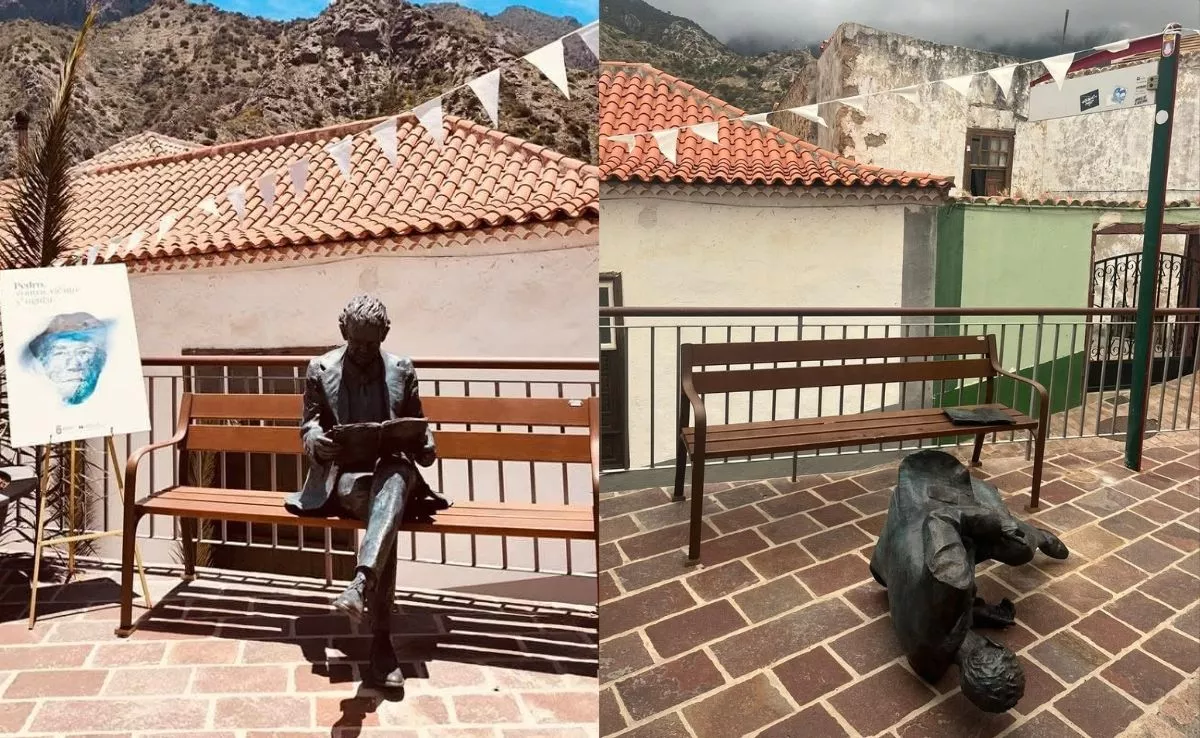
The village of Vallehermoso, on the island of La Gomera, continues to wonder what happened to the sculpture of the renowned Canarian poet, Pedro García Cabrera, which was vandalised this past weekend, almost a month after its inauguration. Pedro García Cabrera is an illustrious son of this Columbian municipality, the largest yet the most depopulated on the island, primarily due to “the lack of jobs and opportunities for the youth,” comments a local resident.
Sources consulted have mentioned to Atlántico Hoy that, while García Cabrera was born in Vallehermoso (19th August 1905), and is a distinguished figure and great poet, there has never been a strong attachment to his figure among the local residents, “perhaps because he left the village and never returned.”
“He left very young. It is said that he did not have a great time here, which is why he left. He only returned once, when he was already famous, but only to Almendrillo, 500 meters from the village, and then he went back to Tenerife. He never came back,” they comment.
“It’s not that he was disliked. They say it seemed that, being famous, he looked down on those from here,” comments the resident consulted, adding that this behaviour has created “some resentment” that has been passed down from parents to children.
“Now it’s the grandchildren of those who shared Pedro’s generation,” the resident highlights.
“The truth is that for the young people here—not all, but many—the sculpture of the poet neither adds nor subtracts. On the day it was placed, there was only a group of people to receive it,” they add.
The resident mentions that on the morning of Sunday, people in the village thought that the damage to the sculpture might be due to it being poorly secured or a “stumble, unintentionally” by someone, “after a night of fun, dancing, and a drink during the festivities,” but after speaking with another local, some doubts were cleared.
“At around three on the Sunday morning, the sculpture was still intact, but a neighbour said that after that time, they saw three young lads tugging at it to try and pull it off the bench,” they point out.
“I repeat, the people of the village do not harbour ill will towards the poet nor is he their target, but the discontent over many things happening perhaps took it out on the sculpture,” they state.
“The politicians have spent a lot of money on the lustrous festivities, and many people in the village are experiencing great hardship,” they assert, indicating that the population of Vallehermoso is ageing “because the young people are leaving.”
Moreover, they emphasise, “being an agricultural village, there is less and less agriculture; even if there is water, agriculture is dead. There is no generational change. There are no jobs, no industry, nothing. People are very fed up…”
On the morning of Sunday, 13th July, the Vallehermoso City Council expressed its strongest condemnation and rejection of the vandalistic act committed against the sculpture of Pedro García Cabrera, located in the historic centre of the municipality.
From the council, they highlight that “the attack constitutes a direct offence to the memory of one of the most relevant figures in Canarian culture of the 20th century and an affront to the identity feelings of an entire village. Pedro García Cabrera not only represents an essential literary legacy but also the values of commitment and freedom that marked his life and work.”
Many people from Vallehermoso and other municipalities, both from within La Gomera and outside, have condemned the vandalism of the poet’s sculpture through various forums and social media.
A resident comments: “Those who commit such acts do not represent the noble and respectful village we are. There should be a thorough investigation, and those responsible should pay accordingly, because ignorance and a lack of civility cannot be allowed space in Vallehermoso.”
“What a regrettable and despicable act. In the end, it comforts us to know that they cannot extinguish something that is immortal, that no matter how hard they try, they cannot erase from our memory a person who is already part of the cultural heritage of Vallehermoso and of humanity,” complains a local woman.















